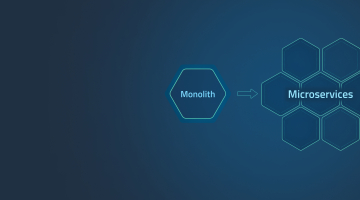

Monolithic vs microservices architecture: Which is better?
In the IT-powered world of the 21st century, people use dozens, if not hundreds, of digital products every day. We read emails, look through the newsfeed of our social media accounts, pay for groceries using e-banking, click on apps to access various services, etc. The involvement of computer technologies is even higher in our professional activities, none of which can do without respective software. And all the programs you use – even the most primitive ones – rely on architecture of a kind.
The notion of software architecture denotes the system’s organization that encompasses the list of components, the way they interact and integrate with each other, the environment in which they function, and the underlying principles of the system’s design. Moreover, visionary software architects see to it that the system has the evolution potential with room to grow.
Small apps involving boxed solution elements can be built without specified and documented architectural decisions. For more complex and professional systems, the explicit definition of a system’s architecture has to be laid out fair and square otherwise, the project is doomed to failure.
We provide professional consulting on software architecture: Check out our services
When is system architecture defined?

When experts design the architecture of a software product, they do it with an eye to its mission as well as its basic safety and availability requirements. It is also critical that the system’s operations shouldn’t interfere with the operation of other devices or tools. Naturally, such a mission must be outlined before the project gets actually launched, so some overarching architectural decisions are made at this initial stage. However, having a decade-long experience in software development, we at DICEUS know well that system architecture is conceptually evolving as long as the project lasts. Why?
While coding and engineering are being implemented, there are always some corrections and improvements to the original plan. Certain approaches don’t live up to expectations and the viability of other concepts turns out dubious. Customers come up with new ideas as to the products’ look, feel, and functionalities. Fresh requirements and novel tech stack crop up, necessitating fine-tuning or total revamping of some components.
Even when the product is launched and has been running for years, architectural changes may also be introduced. Some are conditioned by the exposed inadequacies, while others aim to modernize the solution, make it compatible with innovations, or sustain its functioning (while it is still worthwhile or cheaper than replacing the legacy system with new-generation software).
Yet, whatever possible alterations of the initial design might creep in, all of them must take into account the underlying architecture type. Various digital products can have microkernel, event-based, or other architectural patterns at their foundation. For application development, the principal choice that software architects have to make is related to solving the microservices monolithic dilemma. What is the difference between microservices and monolithic architecture, and when should either type be preferred? Let’s zoom in on each of them.
Related article: Enterprise vs. solution vs. technical architects
What is monolithic architecture?
This is the app development classic. Such apps are built as a single-block unit with a universal code base for all modules. The number of modules depends on the complexity of the project and its prospective features. Typically, such solutions contain a database, a server-side app, and a client-side UI. All their functions are served in one place.
Monolithic architecture pros and cons
Let’s figure out the good and the bad of monolith.
Advantages of monolithic architecture
- Foolproof development. Being practiced for quite a time, monolithic app development today refers to bread-and-butter skills that all software architects must possess. Naturally, it is easy to find experts with expertise of this kind.
- Foolproof deployment. All you have to deploy to run a monolithic app is a single file or directory.
- Better performance. The reason for this is shared memory access utilized in such apps, making them faster if we compare monolithic architecture to microservices.
- Minimal cross-cutting concerns. Logging, caching, and performance monitoring affect the operation of the entire application. In monolithic apps, where all components are hooked up, running them together is considerably simpler.
- Faster debugging and testing. Being a single unit, such apps can be tested and then debugged in (relatively) no time.
- Fewer operational expenses. Not requiring service detection and registration, interservice communication, load balancing, and other microservices, monolithic app development is more cost-efficient.
Disadvantages of monolithic architecture
- Resistance to change. Any attempts at modification or upscaling must be sustained throughout the whole codebase since separate modules of the structure can’t be changed independently. The same refers to introducing new technologies and upgrades into the app. If the app does accept changes (for instance, third-party tool integration), their implementation is extremely time- and effort-consuming.
- The complexity of code. Being utilized across the entire system, the code becomes too complicated and bewildering to understand and manage due to the multiple layers and dependencies it has to cover.
- Programming language limitation. Typically, it allows only one language to write code in. If any element is written in a different language, its integration is impossible.
Is this model still popular with organizations that choose it as a foundation for building their software products?
Monolithic examples scrutinized
Despite its rather cumbrous nature, the monolith is employed by a number of blue-chip brands entirely or for vital elements of their IT environment.
- X (ex-Twitter). It was launched as an app, relying on the Ruby-on-Rails-powered monolithic architecture. Its evolution has ushered in a more distributed structure of the software the company uses. However, parts of the platform never abandon the tried and true older model.
- Basecamp. Like X, this team collaboration and project management tool has the Ruby on Rails framework as the core of its monolithic design.
- Shopify, the world-famous e-commerce platform, is the third name on our list. Its software pattern dynamics are identical, with Ruby on Rails incrementally ousted by microservices, but the transition is not yet complete.
- GitHub retains the lion’s share of its monolithic core functionalities while gradually moving to a more service-oriented architecture.
- Airbnb. The same is true of this platform, which still uses a monolithic codebase for some of its elements while gradually switching over to microservices.
- SoundCloud. The popular artist-first streaming platform was initially built as a monolith. Such components are still in operation, although the brand is significantly migrating to microservices.
- Atlassian, the high-profile producer of team collaboration software, started its market presence by releasing monolithic applications such as Jira and Confluence. Despite the continuing refactoring to microservices, their substantial components still run on the monolith.
As you can see, many major-league brands still use monolithic architecture in their products, yet the general trend of harnessing microservices is evident.
What is microservices architecture?
This is a younger technology, but during its years on the market, it has revolutionized app creation endeavors. The major difference between monolithic and microservices architecture is that the latter contains a collection of independent modules that run every process as a separate service. Each has its scope, database, and operational logic, but they communicate via APIs. Basically, they can be treated as independent software products, which determines microservices’ benefits over monolithic structures.
Microservices architecture pros and cons
The different principles of the organization determine the advantages of microservices architecture sports.
Advantages of microservices architecture
- Independence of components. Each module can be independently deployed and upgraded, which translates into enhanced flexibility, a cost-efficient scalability process, and easier bug detection within each module.
- Relative simplicity. Because it is split into separate elements, the entire system is quite transparent in terms of its functioning and handling.
- Fewer mistakes. Error-generating power is effectively curtailed since the boundaries between units are hard to cross. Thus, for instance, cascading faults never creep into microservices systems.
- Freedom of choosing vendors. You can hire various vendors that excel in building different modules if you need to replace the one that underperforms.
- Freedom of choosing technologies. An essential reason we use microservices over monolithic is the absence of tech stack limitations, as you can switch to a different tool or framework to build another module.
- The agility of onboarding new developers. Since each of them has to know only the nuts and bolts of their module, they can come to grips with their assignment much quicker.
This architecture type has certain shortcomings as well.
Disadvantages of microservices architecture
- Limited usage. The tasks of some apps can’t be split into separate components.
- Cross-cutting issues. Logging, externalized configuration, health checks, and other details require special attention while building a microservices app.
- Connection management. Setting up links between the modules has to be approached with utmost care.
- Additional points of concern. There are multiple complexities that have to be dealt with (data consistency between disparate databases of the services, tool incompatibilities, dealing with multiple frameworks and their languages, and opting for the best microservices pattern, to name a few).
- Greater expenditures. Unit-by-unit deployment and cloud reliance cause the higher cost of the microservices app and even operational overheads.
- Prolonged and more complicated testing and debugging. Each module has to be tested and debugged piecemeal utilizing separate tools and techniques. However, automated testing can somewhat mitigate this problem.
- Slower performance. The complicated system of interconnections and task distribution between modules accounts for the lag in loading speed.
- Greater volume of paperwork. All schema and interface documents are more numerous in comparison to the monolithic architecture apps. Moreover, the necessity to keep them up-to-date may eventually snow you under.
- Security threats. A greater number of software elements spell more potential areas for cyber-attacks. More security risks require more attention to bolster protection measures.
Given the weighty advantages of microservices over monolithic architecture, it is no wonder that companies embrace microservices en masse.
Microservices examples showcased
The global microservices market is predicted to experience triple growth between 2024 and 2028, displaying an explosive CAGR of almost 23%.
Definitely, it is due to the active adoption of the technology by multiple digitally driven businesses, including some behemoths whose growth and expansion are to a no less degree attributed to the timely adoption of microservices.
- Amazon. Having started in the early 2000s as a solely monolithic application, this retail giant faced a problem with untangling numerous dependencies every time an update was released or the software increased in scope. Instead of developing a new system to replace the old unwieldy one, its software engineers broke the monolith into independently running modules, which relied favorably on the site’s operation and allowed the brand to support Apollo, AWS, and other microservices-based products.
- Netflix. Being only one year old, this ecommerce (back then) titan experienced massive service outages and scaling bottlenecks. For three days, it couldn’t ship DVDs, which were all the rage in the late 2000s, to its disgruntled customers, which pushed the management to realize the inadequacy of vertically scaled single points of failure in their data center. They started by migrating non-customer-facing elements (the movie-coding platform) to microservices and then proceeded to refactor customer-facing systems. The transition took Netflix three years to accomplish, but it has created a network of 500+ cloud-based microservices, allowing the streaming platform to handle 2 billion API edge requests daily.
- Uber. Growth hurdles were the main reason for this ride-sharing company to ditch monolith. Its rapidly increasing global operations proved the monolithic app design change-resistant, which became a major halter for Uber’s expansion. The developers decided to break the existing monolith into individual cloud-hosted microservices and add new modules to the system (trip management, passenger management, and the like). Since the alteration was performed early in the business, it was swifter in implementation, enabling the company today to offer first-rate services to its clientele.
- Etsy. This ecommerce platform faced the problem of poor server processing time caused by the impossibility of concurrent API calls within the monolithic structure. When the company launched its mobile app, the situation was exacerbated. Finally, the development team has managed to achieve API concurrency via leveraging cURL for parallel HTTP calls and came up with a system of developer-friendly tools to boost the adoption of the two-layer API. All these changes allow for faster upgrades, no-sweat scaling, and continuous innovation.
As you see, organizations encountered various monolith-related issues that forced them to embrace microservices. Perhaps you experience similar problems, so you should consider monolith-to-microservices migration.
Why should you switch over from monolith to microservices?
Here is a checklist of reasons that can help you understand when you need to refactor your monolithic solution into a microservices one.
- Need for flexibility and customization. The system grounded on microservices is easily modifiable. Following the shifting business requirements, you can remove, add, tweak, and upgrade its elements hand over fist.
- Scalability. Companies start operating with an eye to future growth. By making a microservices product the core of their IT infrastructure, they obtain limitless opportunities to enhance its scope along with the expansion of the organization.
- Minimal time to market. A transparent codebase, straightforward dependencies, easy-to-handle testing, and quick deployment enable rapid delivery of the microservices app to the market and thus reacting promptly to demands and fluctuations there.
- Reduced downtime. You can troubleshoot elements, fix issues, and introduce upgrades without putting the entire solution out of operation. It means you can keep your business workflow going and bringing value even when the product’s functioning is hampered in some aspects.
- Numerous third-party integrations. If your enterprise’s IT ecosystem comprises various elements (ERP, CRM, PIM, etc.), integrating all of them into a single mechanism is a cakewalk with microservices. Besides, this API-driven architecture is extremely susceptible to external integrations, which is a definite forte for companies leveraging social media, geolocation, payment gateways, etc.
- Cost saving. Although migration from monolith to microservices comes at a price, the expenditures can be distributed evenly across the entire transition period. Why? Because you don’t have to migrate in one go. You can do it module-by-module and invest in upgrades by installments.
In case the abovementioned considerations are irrelevant to your current situation, you can continue using your monolithic app. But what if you don’t have any software product but are going to acquire one for your professional initiatives? What should you steer by while selecting the architecture type for it?
How to choose the right software architecture?

There is no universal answer to the question: is microservices better than monolithic? First off, you should rather ask when to use microservices vs monolith. Secondly, to select the architecture type that will be the best fit, you must have a close look at what you have and what you want to obtain.
If you are a small startup on short commons and plan to launch an app of yours as soon as possible, a product with a monolithic architecture is just what the doctor ordered. This option is also good for simple apps that don’t have to be over flexible nor scalable and don’t require superior business logic. Finally, you may lack the expertise to create such a complex product as an app with microservices architecture, so monolith will be the only choice for you.
If you own a full-fledged business and bargain for a scalable app with many modules, functions, and user journeys, you can bet big on microservices. You must remember, though, that such projects can be successfully accomplished only if you can ensure communication — both between services technologically wise and between development teams operationally-wise.
Yet, whatever architecture type of your app you will eventually opt for, it is the implementation that will ultimately bring its triumph – or failure. DICEUS has specialists with sufficient skills and experience to see through an app development project based on any architectural pattern that will impress you with affordability and superb quality, and exquisite design.
Planning to create an app, you should solve several basic organizational and technical problems, one of the most serious of which is choosing the architecture type. To make the right choice between monolith and microservices, it is necessary to review your goals and requirements for the final product as well as gauge the expertise level you can engage to accomplish a project of either type.
FAQ
What is a monolithic architecture?
In it, all the solution’s elements (typically, a databank, a client-side interface, and a server-side) are housed in a single block with a universal code base. Monolithic products are foolproof in development and deployment, fast in debugging and testing, and are cheaper to build.
What is microservices architecture?
This software organization scheme presupposes the existence of loosely coupled modules with their individual database, scope, and operation logic. To link the containers together, a system of APIs is employed, allowing for the flexibility, scalability, and high fault resistance of microservices solutions.
What are the key differences between monolithic and microservices architectures?
While all elements of a monolithic architecture are served in one place and function as a single mechanism, microservices are a sum of loosely connected modules that rely on APIs to communicate with each other. The former model is resistant to upscaling and lacks flexibility, whereas the latter allows for broad customization and is friendly to third-party integrations.
When to use microservices, and when monolith?
Monolith is a better fit for simple apps that don’t require special flexibility or scalability. It is an ideal choice for cash-strapped small companies and startups without an in-house IT team. Enterprise-size organizations having qualified developers on their roster usually need and can afford more complex solutions with sophisticated business logic and multiple modules. For such projects, microservices architecture is the best option.



